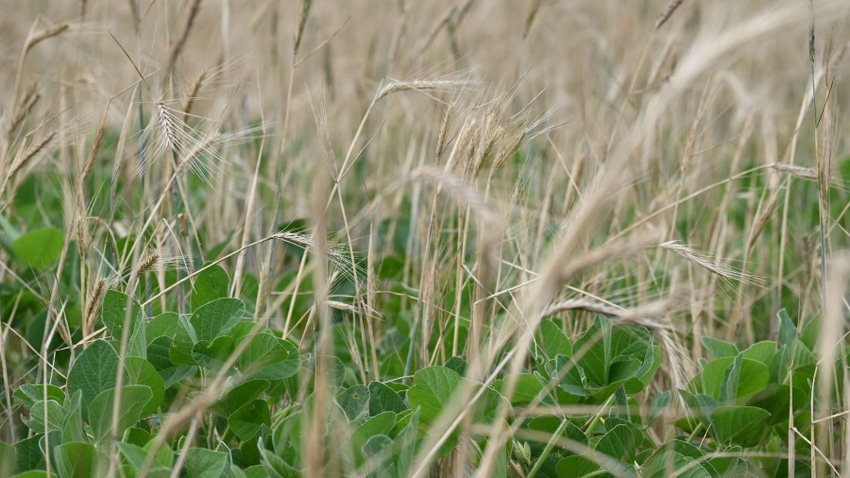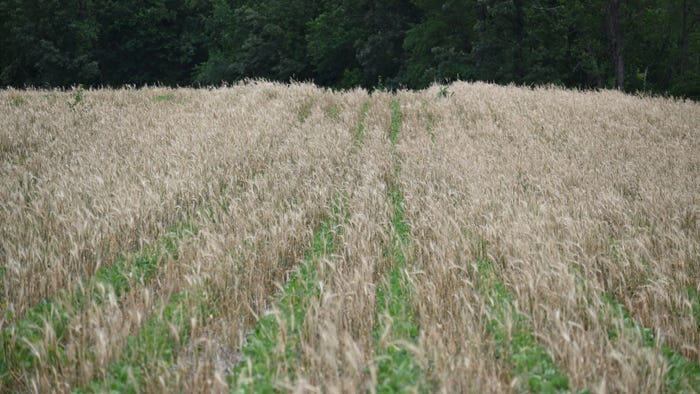September 11, 2023

Cover crops are not new in Iowa, but a new study just getting underway is looking to discover if there are financial, soil health and crop benefits to a slightly different cover crop approach called “relay intercropping.” In simple terms, relay intercropping provides the opportunity for three cash crops in a two-year rotation cycle.
While it has only been tried by a small number of farmers in Iowa, relay intercropping has caught the attention of researchers at Iowa State University (ISU) and the Iowa Soybean Association as something worth learning more about. The study will cover both the mechanics of implementation as well as the social and cultural impacts related to adoption of new practices.
“While it sounds a bit complicated, relay intercropping is a simple tweak on more traditional cover crop practices that merits a closer look to determine impacts and potential benefits beyond today’s standard of cover crop enhancements,” said Mark Licht, associate professor and Extension cropping systems specialist at ISU. “We have worked closely with partners to enroll farms across Iowa to get started on field-scale analysis of the process, as well as the effects on things such as soil health, nutrient loss, water runoff and crop yields.”
Playing integral roles in this multiyear demonstration project are the Iowa Soybean Association, Northeast Iowa Resource Conservation and Development, and ISU Extension and Outreach.
The plan
Beginning after corn harvest in 2023 (mid-October target), farmers will drill winter rye seed. It is expected that the seed will germinate and begin growing before a hard freeze, which will send it into dormancy for the winter. The winter rye plants will provide soil erosion resistance throughout the winter months and will emerge with warmer temperatures in the spring.
“A cold cycle after winter rye germination is an important part of relay intercropping success,” Licht continued. “The vernalization [triggered by freezing] of the plants is what makes the plants produce seed — something that is essential to the cash value of the crop.”
In the springtime, around the time of winter rye stem elongation (vertical growth), soybeans will be planted into the winter rye. In midsummer, when the soybeans are approximately 12 to 14 inches in height, the winter rye will be harvested, leaving the soybean plants to continue maturing until harvest in the fall and winter rye stubble that will help suppress weeds.
Monetization of the winter rye crop could be through collection and sale of seed for future cover crops or as a substitute for corn in cattle and hog feed rations.
An oat cover crop will be planted after the soybean harvest. Selected because it will winter-kill, the oats will hold soil over the winter and contribute biomass without need for termination before corn planting.
The study will also take a comprehensive look at the social and cultural elements which can play an important role in broad adoption of a new or significantly changed practice. Under the guidance of anthropologist and Iowa Learning Farms director, Jacqueline Comito, ISU Extension and Outreach will be conducting qualitative research in parallel with the relay intercropping implementations.
Learning opportunities
Noting that the project presents a rare opportunity for this type of research, Comito is excited to learn from this project. “Particularly in the agriculture sector, where change takes place over long periods of time, we have not had many opportunities to be on the ground and observing the decision-making processes and social influences that take place when something new is tried,” Comito said. “Early adopters can be influencers on their communities as well as subjects of influence in the form of social feedback and peer pressure. We intend to be on the ground observing and gathering information through interviews, participation in events and simply getting to know the communities.”

GETTING MORE: Intercropping allows farmers to get three cash crops in a two-year rotation cycle.
Working with Comito in conducting field observations, preparing mini ethnographies of the communities nearby the test sites, as well as speaking with participants and those with no direct connection to the trials will be Jon Dahlem, ISU Extension and Outreach postdoctoral researcher. Dahlem is an expert in qualitative observation methods, including information collection and assessment of behavior and cultural effects.
“The introduction of new conservation practices is often complicated by farmers’ social identities and the ‘social loss’ a farmer may experience when doing something new,” Comito said. “Understanding generational identities, and tapping into the values they represent, could be one key to broad adoption of new practices such as relay intercropping.”
“Interacting and building relationships with farmers, researchers, agencies, media, neighbors and other community members will allow us to capture information and opinions as they are happening,” Dahlem said. “The results of these conversations should aid in building ethnographies of the surrounding communities in different areas of the state and will ultimately help us to lay the foundation for approaching future outreach and education activities.”
Here are things the project team hopes to learn through the relay intercropping study.
On the farming practice front:
best management practices for seed rates and timing
comparative results in adjacent fields with sole soybeans and relay-intercropped soybeans
incidence of volunteer winter rye in corn rotations and mitigation if needed
soil health and biomass accumulation after a three-year cycle
long- and short-term impacts on productivity and profitability
Social aspects of practice adoption:
relative formal and informal influences on new practice adoption
the importance of community, peer and social opinions and feedback on adoption satisfaction
best practices for new practice introduction, education, promotion and facilitation
The relay intercropping study is funded in part by a Conservation Innovation Grant from the USDA Natural Resources Conservation Service.
What is relay intercropping?
Relay intercropping is a practice in which winter wheat or rye is seeded following corn, soybean is seeded into the winter crop, the wheat or rye is harvested and the soybean is harvested, and oats are planted as a fall cover crop ahead of corn. The system provides three cash crop opportunities in two years.
Ripley is Iowa Learning Farms manager and a Water Rocks! conservation outreach specialist.
About the Author(s)
You May Also Like




